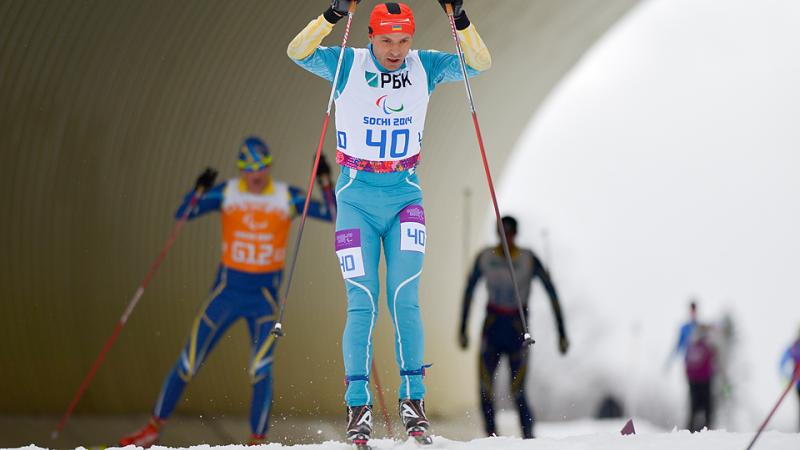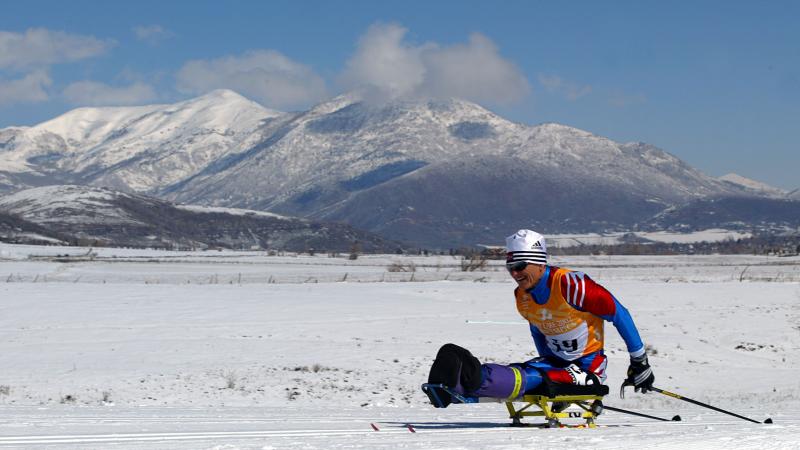HISTORY OF PARA NORDIC SKIING
Para Nordic skiing is the collective name for two different Para sport disciplines: Para biathlon and Para cross-country skiing.
BIATHLON
Biathlon was introduced in Innsbruck in 1988 for athletes with a physical impairment, and in 1992, athletes with a vision impairment also became eligible to compete.
The events consist of a 2.0 or 2.5 km course skied three or five times in the free technique for a total race distance between 6-15 km.
Between the two stages athletes must hit two targets located at a distance of 10m. Each miss is penalised by an increase in the overall route time.
The most important success factor lies in the capability of alternating the skills of physical endurance and shooting accuracy during the competition.
Athletes with vision impairment are assisted by acoustic signals, which depending on signal intensity, indicate when the athlete is on target.
Para biathlon is managed by the International Biathlon Union (IBU) in cooperation with the International Ski and Snowboard Federation (FIS) through a joint Steering Committee.
CROSS-COUNTRY SKIING
Cross-country skiing first appeared at the 1976 Winter Paralympic Games in Örnsköldsvik, Sweden. The competition is open to athletes with a physical impairment and blindness/vision impairment.
Men and women used the classical technique in all cross-country distances until skating was introduced by athletes at the Innsbruck 1984 Paralympic Winter Games.
Since then, events have been split into two separate races: classical and free technique. The new technique, however, was not officially used in a medal race until 1992 in Albertville, France.
Depending on functional impairment, a competitor may use a sit-ski, a chair equipped with a pair of skis.
Athletes with vision impairment compete in the event with a sighted guide.
Male and female athletes compete in sprint, short distance, middle distance and long distance (ranging from 1km to 30km) or participate in a team relay using classical or free techniques.
Para cross-country skiing is governed by the International Ski and Snowboard Federation (FIS).
EQUIPMENT
RIFLE
The rifle shall be any type of air or CO2 rifle of conventional appearance with a five shot clip and in accordance with specifications of the International Union of Shooting's (U.I.T) rule.
For Blind class the rifle will be equipped with electro-acoustic glasses (optronic system). Blind athletes are shooting with an electronic rifle that allows aiming by hearing.
The closer the rifle points to the centre of the target the higher the tone is. The different tones that occur when the rifle is moved, allows the shooter to find the exact centre of the target
TARGET
Biathlon uses metal drop-down targets of which consist of a white target face plate with five target apertures, behind which are five independently operating knock down, falling plate scoring targets. The scoring plates must be black.
A hit must be indicated by the black target circle being replaced by a white indicator disc. The target size has a diameter of 21mm for vision impaired athletes (class B) and 13mm for athletes with a physical disability (class LW).
SIT-SKI
Some athletes with a physical impairment compete from a sitting position using a sit-ski. The chair includes seat belts and other strapping.
SKI
Made from fibreglass, classical skis are usually 25cm to 30cm taller than the height of a skier. They are light, weighing less than 0.45kg each; and narrow, with curved tips and a cambered midsection, which is thicker and arched.
Free technique skis are about 10cm to 15 cm shorter for greater manoeuvring. They are also nominally stiffer and have tips that curve less than classical technique skis. The underside of both types of skis has a groove down the centre to keep the ski straight when going downhill.
GROWTH OF BIATHLON AT THE PARALYMPIC WINTER GAMES
| GAMES | COUNTRIES | MEDAL EVENTS | MALE | FEMALE | TOTAL | TOP 3 COUNTRIES |
|---|---|---|---|---|---|---|
| 1988 | 8 | 3 | 36 | 0 | 36 | 1. FIN 2= NOR 3= SWE |
| 1992 | 12 | 4 | 45 | 0 | 45 | 1. FIN 2. GER 3. EUN |
| 1994 | 20 | 10 | 99 | 27 | 126 | 1. GER 2. FRA 3. NOR |
| 1998 | 19 | 12 | 77 | 31 | 108 | 1. GER 2. FRA 3. SUI |
| 2002 | 17 | 6 | 78 | 26 | 104 | 1. GER 2. NOR 3. NED |
| 2006 | 20 | 12 | 58 | 32 | 90 | 1. RUS 2. UKR 3. GER |
| 2010 | 18 | 12 | 61 | 34 | 95 | 1. RUS 2. UKR 3. GER |
| 2014 | 15 | 18 | 58 | 32 | 90 | 1. RUS 2. UKR 3. GER |
| 2018 | 18 | 18 | 65 | 44 | 109 | 1. UKR 2. GER 3. USA |
| 2022 | 14 | 18 | 50 | 36 | 86 | 1. UKR 2. CHN 3. USA |
GROWTH OF CROSS-COUNTRY SKIING AT THE PARALYMPIC WINTER GAMES
| Year | Countries | Medal Events | Male | Female | Total | TOP 3 COUNTRIES |
|---|---|---|---|---|---|---|
| 1976 | 15 | 25 | 101 | 24 | 125 | 1. FIN 2. NOR 3. SWE |
| 1980 | 14 | 27 | 117 | 31 | 148 | 1. FIN 2. NOR 3. SWE |
| 1984 | 18 | 35 | 155 | 39 | 194 | 1. FIN 2. AUT 3. NOR |
| 1988 | 17 | 38 | 125 | 39 | 164 | 1. NOR 2. FIN 3. CAN |
| 1992 | 18 | 27 | 120 | 30 | 150 | 1. EUN 2. NOR 3. FIN |
| 1994 | 25 | 48 | 136 | 41 | 177 | 1. NOR 2. GER 3. RUS |
| 1998 | 24 | 39 | 150 | 63 | 213 | 1. RUS 2. NOR 3. FIN |
| 2002 | 22 | 32 | 96 | 38 | 134 | 1. NOR 2. RUS 3. GER |
| 2006 | 22 | 20 | 88 | 43 | 131 | 1. RUS 2. UKR 3. CAN |
| 2010 | 23 | 20 | 93 | 49 | 142 | 1. RUS 2. CAN 3. GER |
| 2014 | 22 | 20 | 94 | 53 | 147 | 1. RUS 2. CAN 3. UKR |
| 2018 | 31 | 20 | 98 | 59 | 157 | 1. USA 2. CAN 3. UKR |
| 2022 | 25 | 20 | 90 | 51 | 141 | 1. CHN 2. CAN 3. UKR |
OVERALL BIATHLON PARALYMPIC MEDALS TABLE
| RANK | COUNTRY | GOLD | SILVER | BRONZE | TOTAL |
|---|---|---|---|---|---|
| 1 | Russia | 24 | 27 | 15 | 66 |
| 2 | Germany | 23 | 14 | 19 | 56 |
| 3 | Ukraine | 22 | 28 | 27 | 77 |
| 4 | France | 8 | 5 | 4 | 17 |
| 5 | Norway | 6 | 4 | 8 | 18 |
OVERALL CROSS-COUNTRY SKIING PARALYMPIC MEDALS TABLE
| RANK | COUNTRY | GOLD | SILVER | BRONZE | TOTAL |
|---|---|---|---|---|---|
| 1 | Norway | 78 | 49 | 36 | 163 |
| 2 | Finland | 65 | 46 | 53 | 164 |
| 3 | Russia | 52 | 53 | 39 | 144 |
| 4 | Germany | 28 | 32 | 21 | 81 |
| 5 | Canada | 25 | 7 | 14 | 46 |
TOP 5 MALE PARALYMPIC BIATHLON MEDALLISTS
| RANK | ATHLETE | YEARS COMPETING | GOLD | SILVER | BRONZE | TOTAL |
|---|---|---|---|---|---|---|
| 1 | Vitaliy Lukyanenko (UKR) | 2006-present | 8 | 2 | 2 | 12 |
| 2 | Wilhelm Brem (GER) | 1994-2010 | 3 | 1 | 1 | 5 |
| 3 | Benjamin Daviet (FRA) | 2018-present | 3 | 1 | 0 | 4 |
| 4= | Frank Heofle (GER) | 1992-2002 | 3 | 0 | 1 | 4 |
| 4= | Roman Petushkov (RUS) | 2010-2014 | 3 | 0 | 1 | 4 |
TOP 5 FEMALE PARALYMPIC BIATHLON MEDALLISTS
| RANK | ATHLETE | YEARS COMPETING | GOLD | SILVER | BRONZE | TOTAL |
|---|---|---|---|---|---|---|
| 1 | Verena Bentele (GER) | 1998-2010 | 5 | 0 | 1 | 6 |
| 2 | Mikhalina Lysova (RUS) | 2010-2018 | 4 | 2 | 2 | 8 |
| 3 | Oksana Shyshkova (UKR) | 2014-present | 3 | 3 | 3 | 9 |
| 4 | Olena Iurkovska (UKR) | 2002-2014 | 3 | 2 | 2 | 7 |
| 5 | Alena Kaufman (RUS) | 2006-2014 | 3 | 1 | 1 | 5 |
TOP 5 FEMALE PARALYMPIC CROSS-COUNTRY SKIING MEDALLISTS
| RANK | ATHLETE | YEARS COMPETING | GOLD | SILVER | BRONZE | TOTAL |
|---|---|---|---|---|---|---|
| 1 | Ragnhild Myklebust (NOR) | 1988-2002 | 16 | 0 | 0 | 16 |
| 2 | Verena Bentele (GER) | 1998-2010 | 7 | 2 | 1 | 10 |
| 3 | Tanja Tervonen (FIN) | 1988-1994 | 6 | 1 | 0 | 7 |
| 4 | Tanja Kari (FIN) | 1998-2002 | 6 | 0 | 1 | 7 |
| 5 | Birgitta Sund (SWE) | 1976-1980 | 6 | 0 | 0 | 6 |
TOP 5 MALE PARALYMPIC CROSS-COUNTRY SKIING MEDALLISTS
| RANK | ATHLETE | YEARS COMPETING | GOLD | SILVER | BRONZE | TOTAL |
|---|---|---|---|---|---|---|
| 1 | Brian McKeever (CAN) | 2002-present | 16 | 2 | 1 | 19 |
| 2 | Frank Hoefle (GER) | 1998-2006 | 10 | 5 | 2 | 17 |
| 3 | Terje Loevaas (NOR) | 1980-1994 | 8 | 5 | 0 | 13 |
| 4 | Juoko Grip (FIN) | 1980-1994 | 8 | 5 | 0 | 13 |
| 5 | Pertti Sankilampi (FIN) | 1976-1988 | 7 | 4 | 1 | 12 |

 Facebook
Facebook
 Instagram
Instagram
 Twitter
Twitter
 Youtube
Youtube
 TikTok
TikTok
 Newsletter Subscribe
Newsletter Subscribe


